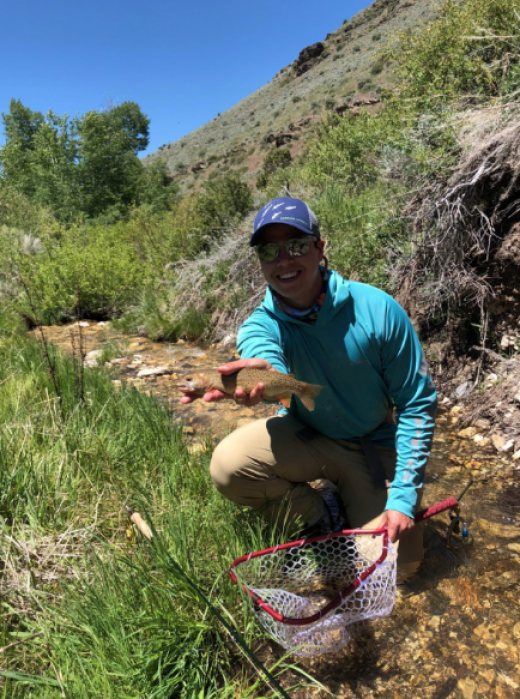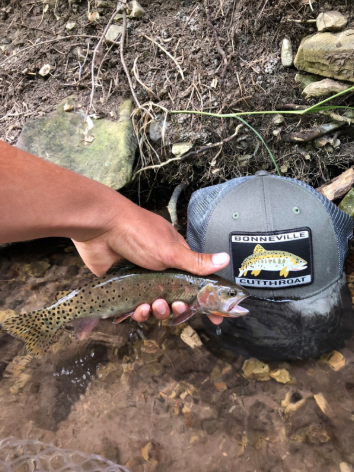Bonneville cutthroat trout, caught in Mill Creek.
By Bobby Boone
I learned to fly fish when I turned ten years old. I caught nothing. I wasn’t even sure if I really liked it.
However, three years later, my first time casting a fly in Utah would ensure that I would fall in love with the sport.
My first day ever out on the Middle Provo was cold, wet, but extremely worth it. I did fall into the freezing water, but also managed to catch the biggest rainbow trout I had ever caught. The next seven years, I spent much time out on the Middle Provo, fly rod in hand. I spent these years eagerly chasing after brown trout with zebra midges and green drakes. Fly fishing had become my hobby.
Anytime I could get out on the water, I was there. Even in the winter, I would try and spend some time on the Middle Provo. I also went to places such as Flaming Gorge, Lee’s Ferry and the Uintas. At this time, my fly fishing adventures were influenced by where I could catch big brown and rainbow trout. As far as I was concerned, those two types of trout were the only ones worth catching.
It was not until 2017 that I had caught my first cutthroat. It was up on the Snake River, in Jackson, Wyo. I had only ever heard about cutthroat trout a few times before this trip, and thought that there was only one species of them. That trip along the Snake sparked my interest in the various types of cutthroat trout. This spark led me to discover the four native species of cutthroats in Utah, as well as the Utah Cutthroat Slam.
During the fall and winter of 2017, I spent my time fishing in search of catching the state fish, the Bonneville cutthroat trout. Why this species before the other three? I had read about its significance and history, as well as the fact that it had been dubbed the Utah state fish. The Bonneville became the fish that I was most fascinated by, and as someone who considered himself a Utah fly fisherman, I felt the need to catch it. Even though I had spent most of my last seven years on Utah’s waters, learning about these cutthroat trout gave me a new desire for exploration. The game had changed on me. My interest was suddenly no longer in pursuing the biggest brown I could land, but rather adventuring into unique areas just to hold a type of fish that truly belonged to where it was caught.
Unfortunately, the fall, winter, and spring yielded no cutthroat trout for me. I did have great success down in Arizona at Lee’s Ferry catching massive wild rainbows (I highly recommend fishing there if you can).
Shortly after my trip down to Arizona, I confirmed that I would be spending my summer up in northern Utah as an intern for Trout Unlimited. Just before I got started with Paul Burnett, I signed up for the Cutthroat Slam. I made it my goal for the summer to complete it. And on the second day of interning, we guided some guys out to Johnson Creek to catch the Yellowstone Cutthroat. After driving four hours and spending twenty minutes crouching under a tree, I finally hooked and landed my first Yellowstone. Absolutely sensational. While I did work hard to actually catch this fish, I felt an indescribable rush when I held it. For the first time, I understood the history of the fish I held, and how unique it truly is.

Yellowstone Cutthroat up on Johnson Creek.
I wouldn’t catch my next cutthroat for the Slam for another five weeks, when I caught my Bear River Cutthroat up in the Uintas. I only had the Colorado River cutt and the Bonneville cutt left, and elected to chase after my Colorado River first; I wanted to end the Slam with the fish that really got me hooked on native cutthroats.
A week later, I set out for the Bonneville, and caught my first one within three minutes of arriving to the stream, and effectively completing the Slam. For me, the Slam is considered my greatest fishing accomplishment ever. None of the fish I caught exceeded eleven inches, but it’s not the size of the fish that made it so special. Catching these native cutthroats in their native water is what made the Slam so momentous for me.
To hold these fish, understanding their history, importance, and uniqueness is an overwhelming feeling for someone who has spent so much of his life pursuing trout. The Slam not only encouraged me to learn about and love native cutthroat trout, but brought me to discover new places and have some great adventures. And while catching fish is the name of the game, fly fishing is about so much more than just catching a trout. It’s about where you are in nature. Fly fishing, especially the Slam, takes you to parts of the wilderness so wild and untouched, that you are reminded of its eminence that makes the sport so exceptional.
For a person who grew up being shaped by fishing and backcountry experiences, and is still being influenced by them, completing the Slam refreshingly delivers that unparalleled feeling of catching a fish on the fly for the first time all over again.
Bobby Boone is a TU intern in Utah.



